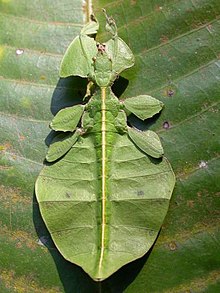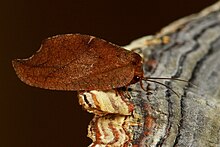140:
215:
80:
159:
235:
17:
52:
where living creatures mimic the form, colour and posture of their surroundings to avoid being noticed from their surroundings by predators depending on sight. One view is that mimesis, being a form of crypsis, differs from
214:
139:
167:
79:
158:
333:
305:
259:
375:
234:
181:
Allomimesis is mimicry of lifeless objects. Some small butterflies resemble bird droppings. Some species of
283:
69:
Zoomimesis is mimicry of different animals. Examples include various visitor species of ants (
221:
8:
225:
87:
347:
348:
Jäger, Gejagte, Parasiten und Blinde
Passagiere - Momentaufnahmen aus dem Bernsteinwald
329:
301:
370:
193:
122:
118:
58:
126:
204:
stage resembled the forest soil. Evidence of this has been preserved in Baltic
364:
102:
41:
278:
114:
70:
25:
106:
110:
21:
182:
148:
328:, volume 4, Spektrum Akademischer Verlag, Heidelberg, Berlin 2005.
243:
186:
185:
living in
African deserts resemble stones and are thus known as "
117:
moths resemble the bark of deciduous trees. Some species in this
54:
49:
33:
197:
61:, mimesis is often counted as one of several forms of mimicry.
205:
201:
130:
16:
287:, volume 3, edition 6. Vieweg & Sohn, Braunschweig 1914.
101:
Phytomimesis is mimicry of plants or parts of plants. Some
355:
26, new series 86, pp. 243-256, 50 figures, Linz 2009.
192:
Allomimesis developed already 50 million years ago in
28:
region resemble tree leaves in appearance and posture.
109:
have a body shape resembling twigs or leaves (as in
91:
stick insect, an ant mimic (adults are phytomimetic)
300:, volume 6, Gustav Fischer Verlag, Stuttgart 1989,
73:), resembling the ants in whose nests they live.
362:
296:Remane, Adolf; Storch, Volker; Welsch, Ulrich:
129:moths, have cocoons resembling tree bark. Some
320:
318:
316:
314:
15:
311:
284:Handwörterbuch der griechischen Sprache
363:
105:resemble thin twigs in appearance.
13:
14:
387:
233:
213:
157:
138:
133:birds resemble broken branches.
78:
96:
339:
290:
272:
260:Adaptive Coloration in Animals
220:Bird droppings: larvae of the
176:
1:
266:
64:
298:Kurzes Lehrbuch der Zoologie
48:, "imitation") is a form of
7:
252:
10:
392:
168:Drepanepteryx phalaenoides
20:The walking leaf insects (
281:; Sengebusch, Max (ed.):
326:Wörterbuch der Ökologie
29:
345:Weitschat, Wolfgang:
222:swallowtail butterfly
19:
376:Animal communication
324:Schaefer, Matthias:
226:Papilio cresphontes
88:Extatosoma tiaratum
30:
383:
356:
343:
337:
322:
309:
294:
288:
276:
240:"Living stones"
237:
217:
161:
145:Leaf-tail gecko
142:
82:
391:
390:
386:
385:
384:
382:
381:
380:
361:
360:
359:
344:
340:
323:
312:
295:
291:
277:
273:
269:
255:
248:
238:
229:
218:
179:
172:
164:Dead leaf moth
162:
153:
143:
99:
92:
83:
67:
12:
11:
5:
389:
379:
378:
373:
358:
357:
338:
310:
289:
270:
268:
265:
264:
263:
254:
251:
250:
249:
239:
232:
230:
219:
212:
178:
175:
174:
173:
163:
156:
154:
144:
137:
121:, such as the
111:walking leaves
103:geometer moths
98:
95:
94:
93:
84:
77:
66:
63:
9:
6:
4:
3:
2:
388:
377:
374:
372:
369:
368:
366:
354:
350:
349:
342:
335:
334:3-8274-0167-4
331:
327:
321:
319:
317:
315:
307:
306:3-437-20436-X
303:
299:
293:
286:
285:
280:
279:Pape, Wilhelm
275:
271:
262:
261:
257:
256:
247:
245:
236:
231:
228:
227:
223:
216:
211:
210:
209:
207:
203:
199:
195:
190:
188:
187:living stones
184:
183:fig-marigolds
171:
169:
160:
155:
152:
150:
141:
136:
135:
134:
132:
128:
127:sallow kitten
124:
120:
116:
112:
108:
107:Stick insects
104:
90:
89:
81:
76:
75:
74:
72:
62:
60:
56:
51:
47:
43:
42:ancient Greek
39:
35:
27:
23:
18:
352:
346:
341:
325:
297:
292:
282:
274:
258:
241:
224:
191:
180:
165:
146:
123:alder kitten
115:Notodontidae
100:
97:Phytomimesis
86:
71:myrmecophily
68:
45:
37:
31:
26:Indo-Pacific
177:Allomimesis
24:) from the
365:Categories
267:References
194:micromoths
65:Zoomimesis
22:Phylliidae
308:, p. 352.
200:in their
149:Uroplatus
57:, but in
253:See also
196:, whose
125:and the
44:μίμησις
371:Mimicry
353:Denisia
244:Lithops
198:quivers
59:English
55:mimicry
50:crypsis
46:mímēsis
38:mimesis
34:biology
332:
304:
202:larval
119:family
85:Young
40:(from
206:amber
131:potoo
330:ISBN
302:ISBN
189:".
113:).
32:In
367::
351:,
313:^
208:.
36:,
336:.
246:)
242:(
170:)
166:(
151:)
147:(
Text is available under the Creative Commons Attribution-ShareAlike License. Additional terms may apply.




